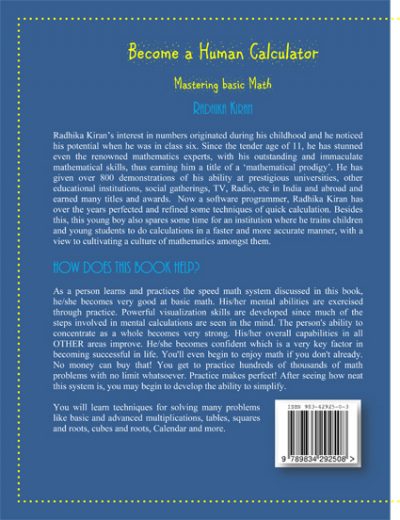In an age dominated by technology, the notion of mental calculation may seem antiquated. However, the process of becoming a human calculator is a pursuit that transcends mere arithmetic; it entails a profound transformation of cognitive capabilities and analytical skills. The ability to calculate mentally not only enhances one’s mathematical acumen but also fosters a deeper understanding of numerical relationships and functions in everyday life. This article delves into the multifaceted approaches to achieving exceptional mental calculation prowess, promising a shift in perspective and stimulating curiosity.
1. Cultivating a Mathematical Mindset
At the core of becoming a human calculator lies a mathematical mindset, characterized by curiosity, persistence, and a willingness to engage deeply with numerical concepts. Embracing the idea that mathematics is not merely a series of rote memorization tasks but a vibrant and interconnected web of ideas is essential. This mindset shifts the perception of mathematics from a daunting endeavor to an engaging puzzle waiting to be solved. Engage with mathematical problems regularly; puzzles, brain teasers, and numerical challenges encourage critical thinking and bolster confidence.
2. Mastering Mental Agility
To hone one’s ability to perform calculations mentally, mental agility is paramount. This agility can be developed through various exercises and techniques. For instance, practicing the breakdown of numbers into manageable segments—known as chunking—enables quicker calculations. Consider the multiplication problem 48 × 6. Instead of grappling with the multiplication directly, one can decompose 48 into (40 + 8), making the calculation (40 × 6) + (8 × 6), leading to a swift resolution. This method exemplifies how simplifying complexity can yield faster results.
3. Harnessing Visualization Techniques
Visualizing numerical relationships can profoundly enhance the ability to perform calculations. Techniques such as the mental number line or the abacus method can facilitate intricate problem-solving. By visualizing numbers as points on a continuum or beads along a string, individuals can grasp abstract concepts more intuitively. Employing color-coding or spatial arrangements can further enhance memory retention and recall when faced with numerical challenges. This cognitive engagement encourages a deeper connection with mathematics beyond simple computation.
4. Utilizing Mnemonic Devices
Mnemonic devices serve as powerful allies in the quest to enhance memory retention and recall of numerical data. Techniques such as the method of loci—whereby information is mentally stored within a familiar spatial environment—can be employed effectively for memorizing sequences and formulas. For numbers, engaging the imagination to construct vivid and absurd narratives can make retention easier. As an illustration, transforming the numerical sequence 3.14159—often associated with pi—into a story about a unique pie can help embed the digits in memory.
5. Engaging with Mental Math Drills
Continuous practice through mental math drills is indispensable for anyone aspiring to become a human calculator. Numerous resources exist, such as apps and online platforms, providing interactive exercises that promote practice in a variety of mathematical operations, including addition, subtraction, multiplication, and division. Implementing consistent drills not only fortifies arithmetic skills but also cultivates speed and accuracy over time. Systematic repetition allows for the internalization of processes, creating an almost instinctive response to mathematical questions.
6. Exploring Advanced Techniques
As proficiency develops, one may consider exploring advanced techniques such as Vedic Mathematics, a set of ancient Indian mathematical techniques designed to simplify calculations. Techniques such as the ‘Vertically and Crosswise’ method for multiplication can drastically reduce computational time. This exploration may also include learning mental algorithms for operations such as squaring numbers, calculating percentages, or performing estimation with ease. Familiarity with these advanced principles can significantly elevate one’s computational prowess.
7. Interdisciplinary Applications of Mental Calculation
The art of mental calculation is applicable across various disciplines, including science, engineering, finance, and everyday decision-making. Understanding the transdisciplinary nature of mathematics underscores its importance in practical situations—such as budgeting, analyzing data, or predicting outcomes. By recognizing these relationships, one’s motivation to master mental calculation is reinforced. The curiosity to apply mathematical skills in multifaceted scenarios fosters further engagement and reinforces the relevance of mental computation.
8. Overcoming Psychological Barriers
The journey to becoming a human calculator is often obstructed by psychological barriers, including anxiety toward mathematics and a fixed mindset regarding one’s abilities. An essential step is to cultivate resilience and a growth mindset—viewing challenges as opportunities for development rather than insurmountable obstacles. Regular self-affirmations and maintaining a positive attitude can significantly mitigate anxiety. Furthermore, it is beneficial to celebrate small successes along the way, recognizing incremental progress as a vital aspect of the learning process.
9. Lifelong Learning and Community Engagement
Finally, fostering a spirit of lifelong learning and community engagement is fundamental in the pursuit of becoming a human calculator. Joining study groups, forums, or clubs dedicated to mathematics can provide invaluable support and resources. Collaboration with peers encourages the exchange of methodologies and insights that enhance one’s understanding and skills. Engaging with a community helps sustain motivation and can introduce novel perspectives that invigorate one’s journey toward mental calculation mastery.
In conclusion, embarking on the journey to become a human calculator is both a cognitive and creative endeavor. It promises to not only enrich one’s mathematical capabilities but also reshape how individuals interact with the numerical elements of their world. With dedication and the right techniques, anyone can unlock their potential and experience the profound joy that mental calculation can bring.












